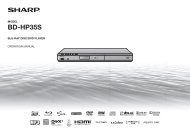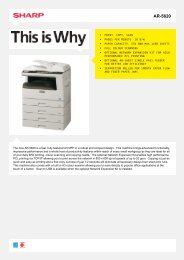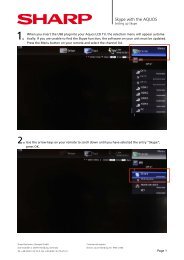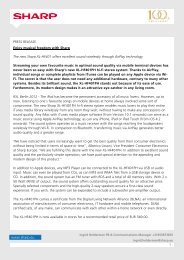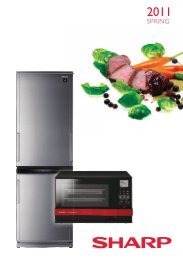R-667-A Operation-Manual GB - Sharp
R-667-A Operation-Manual GB - Sharp
R-667-A Operation-Manual GB - Sharp
You also want an ePaper? Increase the reach of your titles
YUMPU automatically turns print PDFs into web optimized ePapers that Google loves.
TIPS AND ADVICE<br />
FATTY FOODS<br />
Fatty meat and layers of fat cook better than lean<br />
portions of meat. Before cooking, cover the fatty<br />
portions with a piece of aluminium foil or place the<br />
food with the fat side down.<br />
BLANCHING VEGETABLES<br />
Before freezing vegetables, they should be blanched.<br />
This preserves the quality and flavour at their best.<br />
Method: wash and chop the vegetables. Put 250<br />
g of vegetables in a dish with 275 ml water and<br />
cover. Heat for 3-5 minutes. After blanching, immerse<br />
immediately in cold water to prevent further cooking<br />
and then allow to drain. Pack vegetables in an airtight<br />
container and freeze.<br />
PRESERVING FRUIT AND VEGETABLES<br />
Using the microwave for preserving is quick and easy.<br />
There are preserving jars, rubber vacuum seals and<br />
suitable seals made of plastic available<br />
specially made for microwaves.<br />
The manufacturers will supply precise<br />
instructions for use.<br />
LARGE AND SMALL QUANTITIES<br />
Microwave times are directly dependent upon the<br />
amount of food which you would like to thaw, heat or<br />
cook. This means that small portions cook more quickly<br />
than larger ones. As a rule of thumb:<br />
TWICE THE AMOUNT = ALMOST TWICE THE TIME<br />
HALF THE AMOUNT = HALF THE TIME<br />
DEEP AND SHALLOW CONTAINERS<br />
Both containers have the same capacity,<br />
but the cooking time is longer for the<br />
deeper one. You should therefore<br />
choose as flat a container as possible<br />
with a large surface area. Only use<br />
deep containers for dishes where there is a danger of<br />
overcooking, e.g. for noodles, rice, milk etc..<br />
ROUND AND OVAL CONTAINERS<br />
Food cooks more evenly in round or oval containers<br />
than in containers with corners, since the microwave<br />
energy concentrates in the corners and the food in<br />
these areas could become overcooked.<br />
COVERING<br />
Covering the food retains the moisture within it and<br />
shortens the cooking time. Use a lid, microwave foil or<br />
a cover. Foods which are to be crispy, e.g. roasts or<br />
chickens, should not be covered. As a general<br />
rule, whatever would be covered in a conventional<br />
oven should also be covered in a microwave oven.<br />
Whatever would be uncovered in an ordinary oven<br />
can also be left uncovered in a microwave oven.<br />
IRREGULAR SHAPED FOOD<br />
Place the thicker, more compacted end of the food<br />
pointing towards the outside. Place vegetables (such as<br />
broccoli) with the stalks pointing outward.<br />
STIRRING<br />
Stirring the food is necessary, since<br />
the microwaves begin by heating the<br />
outer areas. The temperature is thereby<br />
equalised and the food heats up evenly.<br />
ARRANGEMENT OF FOOD<br />
Place a number of individual portions, such as small<br />
pudding moulds, cups or potatoes in their jackets,<br />
in a circle on the turntable. Keep the<br />
portions at a distance from each other<br />
so that the microwave energy can reach<br />
the food from all sides.<br />
TURNING<br />
Medium-sized items, such as hamburgers and steaks,<br />
should be turned over once during cooking, in order<br />
to shorten the cooking process. Large<br />
items, such as roasts and chickens, must<br />
be turned, since the upper side receives<br />
more microwave energy and could dry<br />
out if not turned.<br />
STANDING TIME<br />
Keeping to the standing time is one<br />
of the most important rules with<br />
microwaves. Almost all foods, which<br />
are thawed, heated or cooked in the<br />
microwave, require a certain amount of<br />
time to stand, during which temperature equalisation<br />
takes place and the moisture in the food is evenly<br />
distributed.<br />
ENGLISH<br />
<strong>GB</strong>-18<br />
R-<strong>667</strong>_[EN ckbk].indd <strong>GB</strong>-18<br />
6/2/09 3:01:59 PM







